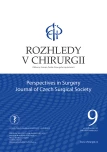Treatment of the congenital thoracic deformity pectus excavatum
Authors:
M. Doucha 1; B. Kučerová 1; N. Newland 1; M. Vyhnánek 1; M. Rygl 1; V. Koucky 2; P. Pohunek 2; J. Šnajdauf 1
Authors‘ workplace:
Klinika dětské chirurgie 2. lékařské fakulty Univerzity Karlovy a Fakultní nemocnice v Motole, Praha, Česká republika
1; Pediatrická klinika 2. lékařské fakulty Univerzity Karlovy a Fakultní nemocnice v Motole, Praha, Česká republika
2
Published in:
Rozhl. Chir., 2023, roč. 102, č. 9, s. 352-355.
Category:
Review
doi:
https://doi.org/10.33699/PIS.2023.102.9.352–355
Overview
Pectus excavatum is the most common chest wall deformity in the Czech Republic. This chest deformity is typically characterized by a wall depression with sternal rotation. If the excavation of the chest wall does not cause any physical or psychological problems, the patient does not need any specific treatment. However, if the deformity is painful, affects the function of the lungs, heart or results in psychological problems, we can propose an appropriate treatment for the specific age category of the patient. Up to 10 years, we choose a procedure that includes targeted exercises and rehabilitation; in the age group of 10–15 years, we can add to the exercises the vacuum bell therapy according to the patient’s wishes and compliance; and in the age category of 16 years and above, the patient can be offered a surgical solution. The Nuss operation (so-called MIRPE – minimally invasive repair of pectus excavatum) is the gold standard in surgical treatment; during this surgery, a patient-shaped bar is inserted retrosternally into the patient’s chest under thoracoscopic control and is left for 3 years. The aim of this article is to describe the most common modern methods used in the treatment of patients with pectus excavatum, supplemented by a historical overview.
Keywords:
pectus excavatum – Nuss operation – MIRPE – sternal hook – vacuum bell therapy
Sources
- Shamberger RC. Congenital chest wall deformities. Curr Probl Surg. 1996 Jun;33(6):469–542. doi:10.1016/s0011-3840(96)80005-0.
- Tocchioni F, Ghionzoli M, Calosi L, et al. Rib cartilage characterization in patients affected by pectus excavatum. Anat Rec. (Hoboken) 2013 Dec;296(12):1813–1820. doi:10.1002/ar.22824. Epub 2013 Oct 29.
- Wachtel FW, Ravitch MM, Grishman A. The relation of pectus excavatum to heart disease. Am Heart J. 1956 Jul;52(1):121–137. doi:10.1016/0002-8703(56)90122-3.PMID: 13326839.
- Kelly RE Jr, Obermeyer RJ, Nuss D. Diminished pulmonary function in pectus excavatum: from denying the problem to finding the mechanism. Ann Cardiothorac Surg. 2016 Sep;5(5):466-475.doi:10.21037/acs.2016.09.09.
- https://www.fnmotol.cz/wp-content/uploads/rehabilitacni-cviceni-pro-pacien-ty-s-vpacenym-hrudnikem.pdf.
- Coulson W. Deformities of the chest. Lond Med Gaz. 1820;4:69–73.
- Nuss D, Kelly RE Jr, Croitoru DP, et al. A 10-year review of a minimally invasive technique for the correction of pectus excavatum. J Pediatr Surg. 1998 Apr;33(4):545–552. doi:10.1016/s0022-3468(98)90314-1.
- Rygl M, Vyhnanek M, Kucera A, et al. Technical innovation in minimally invasive repair of pectus excavatum. Pediatr Surg Int. 2014 Jan;30(1):113–117. doi:10.1007/ s00383-013-3435-0. Epub 2013 Nov 30.
Labels
Surgery Orthopaedics Trauma surgeryArticle was published in
Perspectives in Surgery

2023 Issue 9
- Metamizole vs. Tramadol in Postoperative Analgesia
- Metamizole at a Glance and in Practice – Effective Non-Opioid Analgesic for All Ages
- Possibilities of Using Metamizole in the Treatment of Acute Primary Headaches
Most read in this issue
- Treatment of the congenital thoracic deformity pectus excavatum
- Triple neurectomy following Lichtenstein repair of inguinal hernia
- Surgical therapy of chronic lung allograft dysfunction
- Blood loss during HPB procedures
